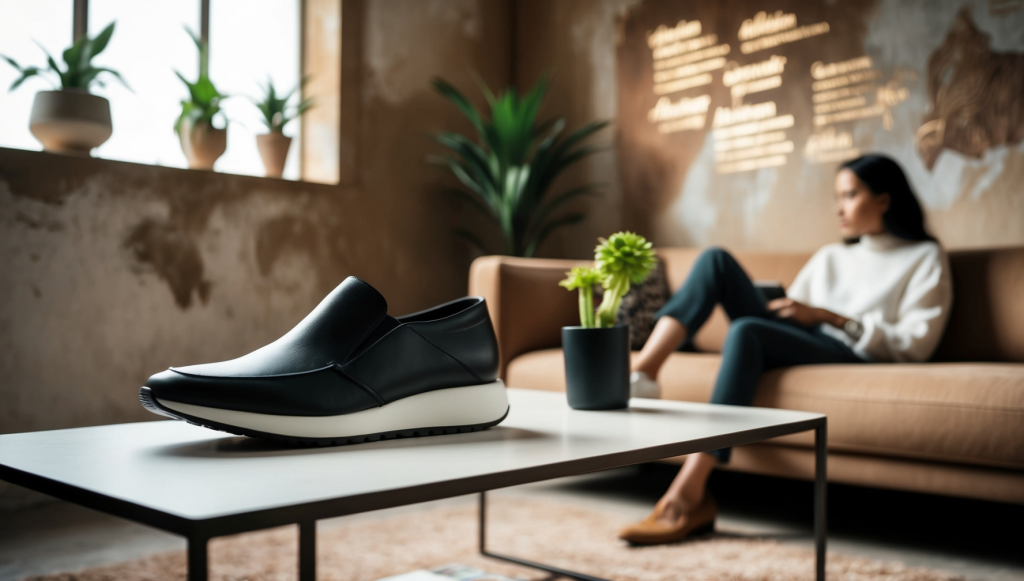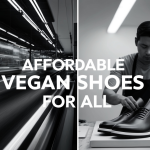As more people embrace cruelty-free lifestyles, the demand for vegan shoes has surged. These shoes, made without animal products, appeal to those seeking to make ethical, sustainable choices. However, while the world of vegan footwear is expanding, it faces unique challenges. From the environmental impact of synthetic materials to durability concerns and consumer awareness, here we explore the main challenges in vegan footwear and innovative solutions paving the way for more sustainable and ethical fashion.
1. Challenge: Environmental Impact of Synthetic Materials
Many vegan shoes rely on synthetic materials like polyurethane (PU) and polyvinyl chloride (PVC), which mimic the look and feel of leather. Although they avoid animal products, these synthetics are typically petroleum-based, meaning they’re derived from fossil fuels and can take hundreds of years to biodegrade. PVC, in particular, releases harmful chemicals during production, posing environmental and health risks.
Solution: Innovating Eco-Friendly Materials
To address these issues, brands are turning to eco-friendly alternatives. For example, companies are developing bio-based materials like:
- Piñatex: Made from pineapple leaf fibers, Piñatex is a biodegradable, leather-like material that doesn’t rely on harmful chemicals.
- Mushroom Leather (Mycelium): Grown from fungi, mushroom leather offers a renewable and biodegradable leather alternative.
- Apple Leather and Cork: These materials are derived from fruit waste and renewable resources, respectively, and are both biodegradable and sustainable.
While bio-based materials can be costly to produce, advancements are making them more accessible to both manufacturers and consumers, gradually replacing traditional synthetics.
2. Challenge: Durability and Quality
A common misconception is that vegan shoes lack durability and comfort compared to leather shoes. Traditional leather is known for its resilience, flexibility, and ability to conform to the foot, which has been hard to replicate with synthetic materials.
Solution: Advanced Material Engineering
Vegan shoe brands are now investing in research and development to improve the durability and comfort of vegan materials. Microfiber-based synthetics and advanced polymers, for instance, offer increased durability and flexibility. Additionally, companies are creating multi-layered synthetic fabrics that emulate the properties of leather, enhancing breathability, stretch, and support.
Some companies, like Will’s Vegan Store and Nae Vegan, use high-quality, specially designed microfiber that is breathable, weather-resistant, and made to withstand extensive wear. Brands are also exploring new manufacturing techniques that increase the durability and comfort of vegan shoes, making them more appealing to consumers.
3. Challenge: High Production Costs
Eco-friendly materials often come at a higher price point, which can increase the cost of vegan shoes compared to traditional footwear. Sustainable practices, including ethical labor and environmentally conscious sourcing, also contribute to production costs. This pricing can limit accessibility, particularly for consumers on a budget.
Solution: Scaling Sustainable Production
As the demand for vegan and eco-friendly materials grows, production costs are gradually decreasing. Larger brands have started incorporating vegan materials into mainstream products, helping to drive down costs. Some vegan shoe companies are working toward partnerships with suppliers to source materials in bulk, reducing costs while still upholding ethical practices.
Additionally, the development of large-scale production facilities for sustainable materials, such as those specializing in Piñatex or mycelium leather, makes eco-friendly materials more affordable. Brands are also focusing on building loyal customer bases by emphasizing durability and versatility, making vegan shoes a long-term investment rather than a disposable fashion item.
4. Challenge: Limited Consumer Awareness
Although veganism is gaining popularity, many consumers are still unaware of vegan alternatives in footwear or may not understand the ethical or environmental benefits of choosing vegan shoes. Some consumers may think vegan shoes only come in specific styles or are only for those with vegan lifestyles.
Solution: Education and Transparent Marketing
Brands are using social media, blogs, and influencer partnerships to educate consumers about the impact of their choices and the benefits of vegan shoes. Transparency in marketing is essential, companies like Matt & Nat and Beyond Skin share details about their materials, production processes, and environmental goals, helping consumers make informed decisions.
In addition to marketing, some brands are encouraging retailers to promote vegan options alongside traditional footwear, making it easier for consumers to find and consider vegan alternatives. Labels such as “PETA-Approved Vegan” or “Vegan Society Certified” are also effective ways to signal authenticity and help consumers easily identify vegan shoes.
5. Challenge: Design Limitations and Aesthetic Diversity
Vegan shoes have historically faced criticism for limited style options. While this has changed, and vegan fashion has evolved significantly, there’s still room for greater diversity in style, colors, and aesthetics in vegan footwear.
Solution: Expanding Design Innovation
Vegan footwear companies have invested heavily in design innovation, working with designers and material engineers to create vegan shoes that look and feel just as stylish as traditional shoes. Some high-fashion vegan brands now offer diverse collections that include everything from sneakers to boots, heels, and dress shoes, ensuring there’s something for everyone.
The rise of digital tools and 3D modeling has allowed designers to experiment with vegan materials and produce intricate designs and finishes that rival leather’s aesthetics. As more designers join the vegan fashion movement, the options for stylish, trend-forward vegan shoes continue to expand.
6. Challenge: Biodegradability and End-of-Life Disposal
Even some of the more sustainable vegan shoes still pose challenges at the end of their life cycle. While vegan materials often minimize animal exploitation, synthetic materials can take hundreds of years to decompose.
Solution: Recycling and Biodegradable Materials
Some brands, like Native Shoes and Rothy’s, have introduced recycling programs that allow customers to return old shoes for proper disposal or repurposing. These companies take responsibility for the end-of-life phase, turning worn-out shoes into raw materials for new products.
Brands are also exploring fully biodegradable materials that can break down naturally over time. This includes cork, hemp, and organic cotton, which decompose quickly without leaving harmful residues. As these materials gain popularity, the need for sustainable disposal solutions will be met, making vegan footwear a fully ethical option from start to finish.
7. Challenge: Ethical Labor Practices
Producing vegan shoes ethically goes beyond materials; it requires ensuring fair labor practices in factories. Unfortunately, the fast fashion industry is notorious for poor working conditions, and even some vegan shoe brands outsource production to factories with questionable labor standards.
Solution: Embracing Fair Trade and Local Production
Some vegan brands, like Allbirds and Veja, prioritize fair wages and safe working environments by adhering to fair trade principles and maintaining transparency with customers. Many companies have shifted production to local factories or actively work with third-party auditors to verify ethical labor practices.
For consumers, choosing certified vegan shoes from companies committed to fair labor standards ensures that their purchase supports workers’ rights alongside animal welfare and environmental sustainability.

Challenges and Solutions in the World of Vegan Shoes
The vegan footwear market is rapidly evolving, but it still faces significant barriers to widespread adoption. Understanding these challenges and exploring potential solutions is crucial for the growth of this ethical and sustainable industry. Here’s a detailed look at the main barriers, cost reduction strategies, innovative materials, consumer perceptions, and the role of celebrities in promoting vegan footwear.
Main Barriers to Widespread Adoption of Vegan Shoes
- Consumer Perceptions of Quality: Many consumers still believe that vegan shoes lack the durability and craftsmanship associated with traditional leather footwear. This perception can deter potential buyers who prioritize quality and longevity in their purchases. Overcoming this bias is essential for market growth.
- Higher Price Points: Vegan shoes often come at a premium due to the costs associated with ethical sourcing and sustainable materials. On average, vegan footwear can be 20-30% more expensive than leather alternatives, which may limit accessibility for price-sensitive consumers.
- Limited Availability of Materials: The sourcing of high-quality vegan materials that can match leather’s performance remains a challenge. The current supply chain for vegan materials can be complex, leading to production delays and limited product diversity.
- Lack of Consumer Awareness: Despite growing interest in ethical fashion, many consumers are still unaware of the benefits of vegan footwear. Misconceptions about style options and comfort can hinder adoption .
- Counterfeit Products: The rise of counterfeit brands offering lower-quality vegan shoes at reduced prices can damage consumer trust and perceptions of legitimate vegan brands.
Strategies for Reducing Production Costs
To make vegan shoes more accessible, brands can consider several strategies:
- Economies of Scale: Increasing production runs can help reduce costs per unit by leveraging bulk purchasing of materials. As demand grows, brands can negotiate better prices with suppliers .
- Innovative Manufacturing Techniques: Investing in new manufacturing technologies can streamline production processes and reduce waste, ultimately lowering costs.
- Collaborations with Non-Profits: Partnering with organizations focused on sustainability can provide access to funding or resources that help offset production costs while promoting ethical practices .
- Material Innovation: Developing cost-effective alternatives to traditional materials can help lower expenses while maintaining quality. This includes exploring plant-based leathers or recycled materials that are less expensive than conventional options.
Innovative Materials Being Developed for Vegan Shoes
The vegan footwear industry is seeing exciting developments in material innovation:
- Piñatex: Made from pineapple leaf fibers, Piñatex is a sustainable alternative to leather that is both durable and biodegradable.
- Recycled Plastics: Brands like LØCI are creating shoes from recycled ocean plastic, addressing waste issues while providing stylish options.
- Upcycled Materials: Companies like Allbirds are using upcycled rice and citrus peels to produce their first vegan shoe line, demonstrating a commitment to sustainability without sacrificing style .
- Natural Fiber Composites: Innovations such as those from Natural Fiber Welding focus on creating materials entirely from plants and minerals, which are designed to be circular and environmentally friendly.
Impact of Consumer Perceptions on Market Growth
Consumer perceptions significantly influence the growth of the vegan shoe market:
- Quality Concerns: If consumers continue to view vegan shoes as inferior, they may be reluctant to switch from traditional leather options. Effective marketing campaigns highlighting quality improvements and stylish designs are essential to changing these perceptions .
- Price Sensitivity: Many consumers prioritize cost over ethical considerations, making it crucial for brands to demonstrate the long-term value of investing in vegan footwear through durability and sustainability.
- Awareness Campaigns: Educating consumers about the environmental and ethical benefits of vegan shoes can help shift perceptions and encourage adoption among a broader audience.
The Role of Celebrities in Promoting Vegan Footwear
Celebrities play a pivotal role in elevating the status of vegan footwear:
- Influencer Marketing: High-profile endorsements from celebrities can significantly boost visibility and desirability for vegan shoe brands. When well-known figures advocate for ethical fashion choices, it encourages their followers to consider similar purchases .
- Fashion Collaborations: Collaborations between celebrities and vegan shoe brands often result in limited-edition collections that attract attention and drive sales while promoting sustainability.
- Cultural Shift: As celebrities increasingly embrace veganism and sustainable fashion, they contribute to a cultural shift that normalizes cruelty-free choices within mainstream fashion.
The challenges facing the vegan shoe market are multifaceted but not insurmountable. By addressing misconceptions about quality, reducing production costs through innovative practices, developing new materials, enhancing consumer awareness, and leveraging celebrity influence, the industry can overcome barriers to widespread adoption. As consumer preferences continue to shift towards ethical choices, the future looks promising for shoes that are vegan, paving the way for a more sustainable fashion landscape.
Moving Toward a Sustainable Future for Vegan Shoes
The world of vegan shoes is growing and evolving, addressing challenges head-on with innovative solutions. While issues like environmental impact, high costs, and consumer awareness remain, the industry is making strides toward creating footwear that is not only animal-friendly but also eco-conscious and ethical.
With increased consumer demand, continuous innovation, and a commitment to transparency, vegan shoe brands are showing that ethical fashion can be both stylish and sustainable. As we continue to prioritize compassion and responsibility in fashion, vegan shoes are paving the way for a future where every step we take can make a positive impact on the planet and all its inhabitants.







